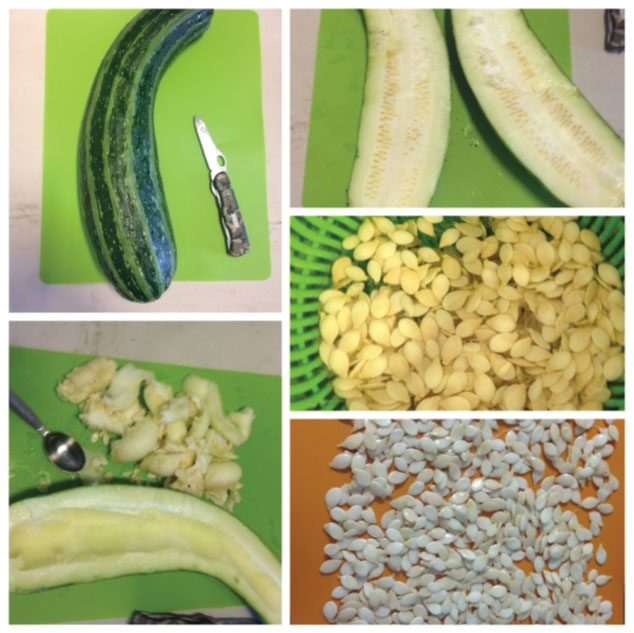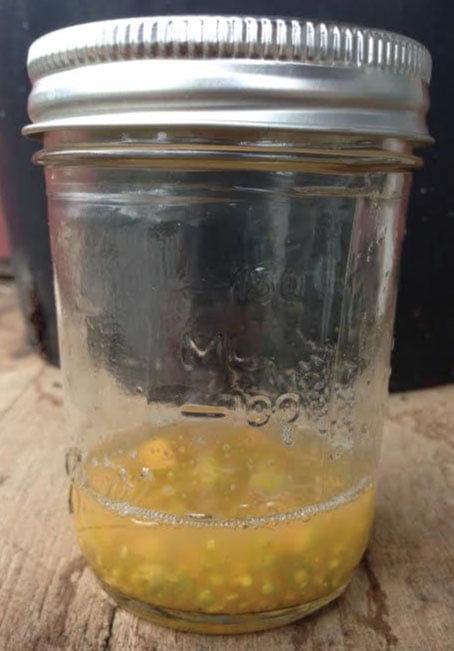Seed Saving Guide

Saving seeds from the garden is one of the easiest and most often overlooked projects on a gardeners list. Knowing where and how your seed was grown to go a long way to comfort many gardeners. Keeping seeds from the best looking and tasting fruits from a plant can lead to an improved crop the following year. Just imagine doing this for a few years what kind of fruits you will be getting. Heirlooms are seed varieties that have been passed down for generations. Grow your own and you can pass them down to your children!
Below is a table to help you learn the ins and outs of seed saving. Its not as simple as growing and harvesting. Many varieties need to be separated by large distances to avoid cross-pollination. Also hybrid vegetable seeds can not be used. Follow the guide below and you will.
| Vegetable |
Seed Saving Technique |
| Beans | Bean flowers are self-pollinating and almost never cross-pollinate. Use caution and plant different varieties 10 feet apart. Save the seeds from the largest, early maturing, best tasting plants. Let seed pods completely dry and crush in sack. Separate pods from seed. |
| Beets | Biennial seed saving. Beet varieties will cross-pollinate and must be separated by .5 miles (2,600 feet) from other beets. In fall pull up beet plant, trim leaves to 2″ and store in a root cellar over the winter. Roots store 4-6 months at 32-40° F. Replant in the spring and harvest seed heads when dry. |
| Broccoli | Biennial seed saving. Isolate broccoli by 1 mile (5,200 feet) from all other Brassica oleracea. In fall remove plants from soil and pot them in sand. Store plants between 32-40° F. Transplant back outdoors in early spring and allow to bolt. Harvest seed pods when dry and clean by hand. |
| Brussel Sprouts | Biennial seed saving. Isolate brussel sprouts by 1 mile (5,200 feet) from all other Brassica oleracea. In fall remove plants from soil and pot them in sand. Store plants between 32-40° F. Transplant back outdoors in early spring and allow to bolt. Harvest seed pods when dry and clean by hand. |
| Cabbage | Biennia seed saving. Isolate cabbage by 1 mile (5,200 feet) from all other Brassica oleracea. In fall remove plants from soil and pot them in sand. Store plants between 32-40° F. Transplant back outdoors in early spring and allow to bolt. Harvest seed pods when dry and clean by hand. |
| Carrots | Biennia seed saving. Isolate carrots by .25 miles (1,300 feet) from other varieties to avoid cross-pollination. In fall pull up carrot roots, trim leaves to 1″ and store in a root cellar over the winter. Roots store 4-6 months at 32-40° F. Replant in the spring and harvest seed heads when dry. |
| Cauliflower | Biennia seed saving. Isolate cauliflower by 1 mile (5,200 feet) from all other Brassica oleracea. In fall remove plants from soil and pot them in sand. Store plants between 32-40° F. Transplant back outdoors in early spring and allow to bolt. Harvest seed pods when dry and clean by hand. |
| Corn | All corn varieties will cross-pollinate within 1 mile (5,200 feet) of each other. Hand pollinate if varieties are grown closer than this distance. Allow ears to dry on the stalk, harvest, and shell seeds. Remove any debris. |
| Cucumbers | All cucumber varieties will cross-pollinate within .25 miles (1,300 feet) of each other. Cucumbers should be large and turning yellow when harvested. Cut lengthwise, scoop out seeds, wash, and dry. Seeds are dry when they break instead of bending. |
| Eggplant | All eggplant varieties will cross-pollinate within .25 miles (1,300 feet) of each other. Let the fruits grow far past maturity before harvesting out seeds. Seeds should be scooped out, washed and dried. Seeds are dry when they break instead of bend. |
| Lettuce | Lettuce rarely cross-pollinates but should be kept 15′ away from other varieties to be harvested for seed. Lettuce to bolt and form seed stalks. Over a 2-3 week period repeated harvest may be needed to capture most seed. Dried seed should be knocked off stalk. |
| Melons | All melon (cantaloupe, muskmelons, & honeydews) varieties will cross-pollinate within .25 miles (1,300 feet) of each other. Harvest when eating quality. Seeds should be scooped out, washed and dried. Seeds are dry when they break instead of bend. |
| Okra | All okra varieties will cross-pollinate within 1 mile (5,200 feet) of each other. Okra pods will dry out and turn brown on plant. Harvest when first pod begins to split open. |
| Onions | Biennia seed saving. All onion varieties will cross-pollinate within 1 mile (5,200 feet) of each other. In fall harvest only large and uniform onions and store in a root cellar over the winter. Roots store 3-6 months at 32-40° F. Replant bulbs in the spring and harvest seed heads when dry. |
| Peas | Peas rarely cross pollinate but should be separated by at least 50′. Allow pods to turn brown and to dry on the plant before harvesting. Break pods from beans and remove pods. |
| Peppers | All pepper varieties will cross-pollinate within 200 ft (sweet pepper) and 800 ft (hot pepper) of each other. Harvest peppers that are ripe and healthy. Remove seeds from core and dry. Seeds are dry when they break instead of bend. |
| Pumpkins | All pumpkin varieties will cross-pollinate within .25 miles (1,300 feet) of each other. Harvest pumpkins that are ripe and healthy. Remove seeds from inside. Wash and dry. Seeds are dry when they break instead of bend. |
| Radish | Radish varieties will cross-pollinate and must be separated by .5 miles (2,600 feet) from other radish. Radish seed stalks will grow up to 3′ tall. Discard early bolting as this is undesirable. The seed stalk is harvested when the stalk and pods are dry. Seeds can then be separated by hand. |
| Spinach | Spinach varieties will cross-pollinate and must be separated by .5 miles (2,600 feet) from other spinach. Harvest seeds when they are completely dry on the plant. Seeds can be sharp so take precaution. |
| Squash | All pumpkin varieties will cross-pollinate within .25 miles (1,300 feet) of each other. Allow fruits to mature 2-3 months past prime before harvesting for seed. Seeds should be scooped out, washed and dried. Seeds are dry when they break instead of bend. |
| Tomatoes | Cross-pollination between tomatoes hardly every happens, except potato leaf varieties that should have 25′ distance between them. Pick the tomatoes with the most desirable traits 1 week past prime picking. Scoop seeds into jar for fermenting. Use same amount of water as seeds in jar. Let ferment for 3-4 days until slight mold begins to grow. Seeds on bottom are healthy and ready to be dried. |

Fermentation (Wet Seeding):
This process makes cleaning seeds much easier by removing the gel coating around seeds. The two most common seeds to ferment are cucumbers and tomatoes.
1. Place seeds and pulp in container. Add same amount of water as seeds and pulps to container.
2. Keep seeds in a warm area for 48-72 hours. Stir or shake fermentation container 3-4 times every day to increase air intake.
3. Mold may occur on top but is not a problem. Continue to ferment.
4. When most seeds have fallen to bottom you can slowly decant and rinse seeds inside.
5. When all pulp and gel has been removed and seeds are clean they can be laid out to dry.
